Welcome! Here you will find information about the Shitanoya site, a national Japanese treasure. We await your visit!
The Shitanoya site is the sites of the settlement in the Jomon period, 5,000 to 4,000 years ago. This site was designated as a national historic site on March 10, 2015 and is one of the largest archeological sites of a Middle Jomon period settlement in southern Kanto region.
Higashi-Fushimi in Nishitokyo City is only 30 minutes by train from Shinjuku that is one district in the heart of the Tokyo metropolis. An ancient romance sleeps at the foot of the city.
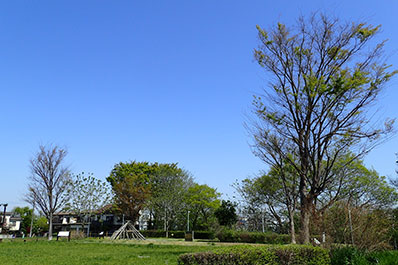
Shitanoya Archaeological Park (Photo from April 2016) 1
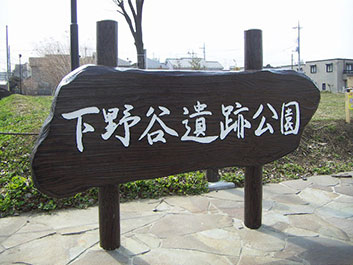
Shitanoya Archaeological Park (Photo from April 2016) 2
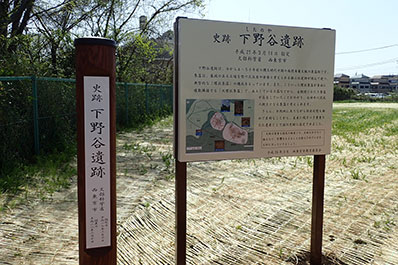
Shitanoya Archaeological Park (Photo from April 2016) 3
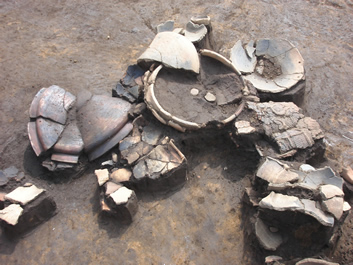
Pottery found below the ground
These are "Shiita" and "Noya". They lived in Shitanoya Village that was a part of the Shitanoya site in the Jomon period. Now they are publicity ambassadors for the site, sharing the appeal of the village, the hometown of the Jomon people.
Follow along for the story of the Jomon period considered the origin of Japan and of the Shitanoya site!
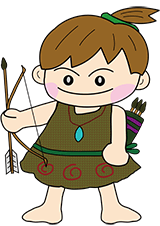
Shiita of Shitanoya Village ©T&K/Nishitokyo City
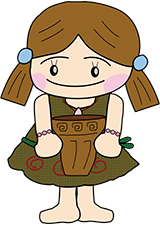
Noya of Shitanoya Village ©T&K/Nishitokyo City
What is the Jomon Culture?

Shiita: You can read here about Jomon culture that was the distinctive culture of the Japanese islands where people and nature coexisted with each other in the nostalgic, Japanese original landscape.
Neolithic culture special to Japan
As the Ice Age was coming to an end, Neolithic culture was developing around the world with agriculture and livestock breeding as the main means of survival.
In the Jomon period, means of sustenance were the same as those in Paleolithic culture where hunting and gathering were primary, but the people had technology for creating pottery and ground stone tool and they built villages and settle down in one place, showing features of Neolithic culture. It can be considered a unique style of Neolithic culture that developed in the waterlocked islands of Japan.
Invention of pottery and the beginning of Jomon culture
Currently, the oldest pottery discovered in the Japanese islands was excavated at the Odai Yamamoto site in Aomori Prefecture, and carbon-14 dating (with calibration) estimates it to be about 16,000 years old. The people on the Japanese islands discovered the chemical change of earth hardening when it is put on a fire and applied this discovery to make tools for sustenance much earlier than other places in the world.
Pottery was a momentous invention, not limited to simply changes in tools. The invention of pottery in which food can be stewed for a long time made it possible to remove the harshness harsh taste of chestnuts, acorns, and other nuts from broad-‐leaved trees. The sterilizing and softening effects of boiling widened the range edible foods available, prompting the development of sedentismsettlements where people could live sedentary lives.
As the invention of pottery led to these major lifestyle changes, this period, although still part of the final stage of the Ice Age of repeated alternating hot and cold temperatures, was also the start of the Jomon period that began with the discovery of pottery.
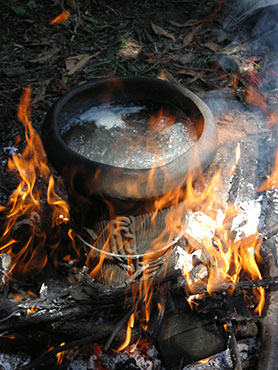
Image of cooking with pottery
Chronological division of the Jomon period
The oldest Jomon pottery is pottery with a pointed base, and they were decorated simply with nail impressions or by wrapping the pots in thin clay ropes. However, the shapes and patterns later changed with the local trends as each period passed. The ‘pottery chronology’ summarizes the changes in pottery by year and region and is used as a measure for the Jomon period.
Summarizing those changes by stage divides the Jomon period into six phases: Incipient, Initial, Early, Middle, Late, and Final.
Jomon pottery is known for its rich artistic qualities, including its shapes and patterns, and receives focus as one example of primitive art.
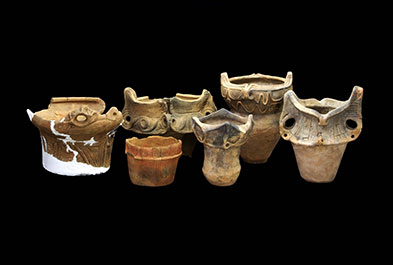
Pottery excavated from the Shitanoya site from the Middle Jomon period
Jomon marine transgression
As the Ice Age ended about 10,000 years ago, the earth began to warm. This caused the sea levels to start rising. The warming had progressed the furthest in Japan in the Early Jomon period, about 6,000 years ago, when the temperature is said to have been about six degrees higher than it is now on average. The ocean crept inward onto the land, and the Tokyo lowland became the sea floor. This is called "Jomon marine transgression". The mouth of the Shakujii-gawa River swelled inwards as far as present day Asukayama in Oji, Kita Ward.
Through the four seasons and the blessings of nature
The Japanese islands developed the four seasons we have today (spring, summer, autumn, and winter), and formed into a gorgeous landscape covered in lush forests and mountains and surrounded by the sea. The Musashino Plateau where Nishitokyo City is located became covered in broad-leaved tree forest and the Shakujii-gawa River that runs through the north of the Shitanoya site and the area around the river were even richer in spring water than it is today. You could see as far as the Kanto Mountains and Mt. Fuji off in the distance.
The Jomon people were blessed with this natural environment and coexisted with it while devising new ideas.
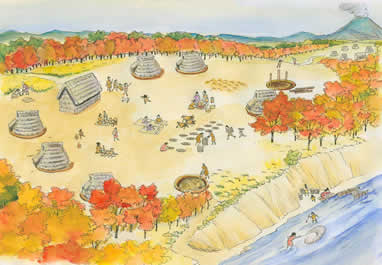
What is the Shitanoya site?

Noya: Now are you familiar with the Jomon period we lived in?
You can start from here to learn more about the Shitanoya site.
Reaching the Middle Jomon period about 5,000 years ago, the number of sites in and around East Japan increased exponentially and evidence of large settlement can be found. It is thought that the population grew rapidly because the natural environment and society became stable.
At this time, a large settlement also developed in the Shitanoya site in Nishitokyo City.
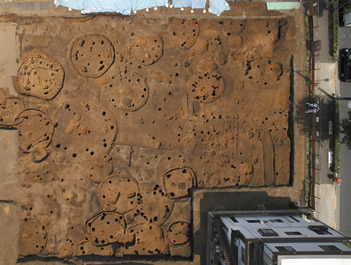
Dwelling sites of the closely-formed living areas from the Jomon period. It can be seen that there was a major settlement here.
The Shitanoya site spread out as far as 2-, 3-, and 6-Chome in Higashi-fushimi, Nishitokyo City, and is a large site spanning about 134,000 m2 (equal to about three Tokyo Domes).
The site is in the middle of a residential area that is a 10 minute walk from Higashi-fushimi station on the Seibu-shinjuku line. Many archaeological sites have been discovered in Japan, but, in urban areas where development has progressed, most sites disappear after excavation and record taking. It is extremely rare for such a large archaeological site to remain in such an urban environment.
Nishitokyo City has a diverse history as a suburban farmland and as a town place along the Ome Highway ("Ome-Kaido"), for example. After the war, it developed into a commuter town and took its current form in 2001 when Hoya City and Tanashi City merged.
Aerial photographs show a green area like an urban oasis in the middle of a closely-packed residential zone. This place that has trees growing along the river, parks, and university fields is the resting ground for Shitanoya Village, a large Jomon period settlement.
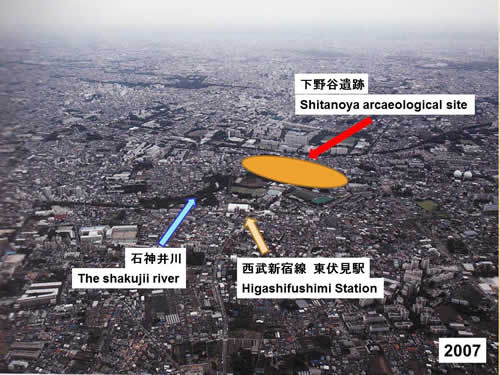
The sites in the Metropolis (2007 aerial photo)
Many Jomon tools and stone tools had been discovered in the area around the Shitanoya site when cultivating fields even before World War II, and archaeologists expected there was a huge archaeological site there.
Then, in 1950, it was described in print and became officially known as an archaeological site.
From the 1970’s, as many houses and condominiums were being built in Nishitokyo City, people began to worry that development would cause the archaeological site to disappear. In 1973, researchers, students, community residents, and others carried out the first excavation. Many investigations were carried out after that, and although part of the site was lost, it became clear that there had once been a large settlement there in the Jomon period.
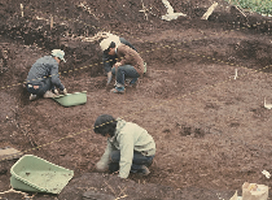
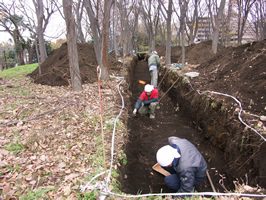
About one tenth of the site has been investigated so far, including the remains of over 400 homes and a vast number of pottery and stone tools.
Remains are being found of early modern fields and other traces of human activity spanning a long time starting in the Paleolithic period that preceded the Jomon period and focusing mainly in the Initial and Middle phases of the Jomon period. In particular, it became clear that this site that is rich with content is one of the largest archaeological sites of a Middle Jomon period settlement in the southern part of the Kanto region.
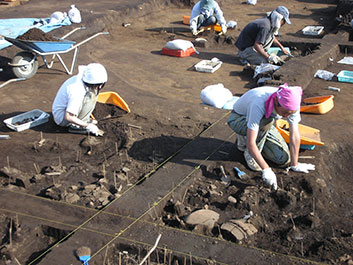
Scene from the excavation
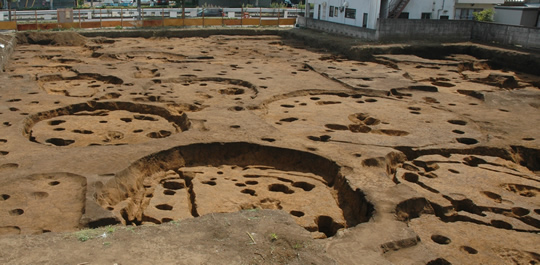
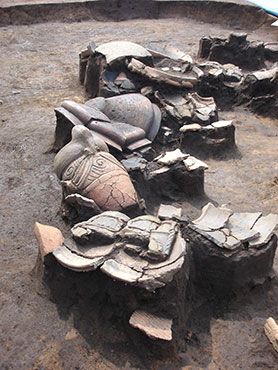
Large amount of pottery that was excavated
Nishitokyo City is located in the Musashino Plateau, an alluvial fan created by the flow of water from the Kanto Mountains that is located on the west side of the Kanto region. The many rivers flowing like tree branches in a fan shape through the alluvial fan carved out the valley.
The altitude of the land where the Shitanoya site is located is between 50 and 60 meters, and the area is surrounded by spring water. Shakujii-gawa River runs through the north of the Shitanoya site, and the area north of that is a wide stretch of lowland. This lowland is currently the field of Waseda University, but, in the late 20’s, it was a swampland thick with reeds where fireflies lived. Plenty of spring water welled from the earth in the Middle Jomon period when large settlements thrived in the Shitanoya site, and the landscape was thought to have been marshland.
Shitanoya Village that is the large settlement whose remains are in the Shitanoya site was built by cutting a clearing through the forest on the high plains that were full of springs and received plenty of sunlight.
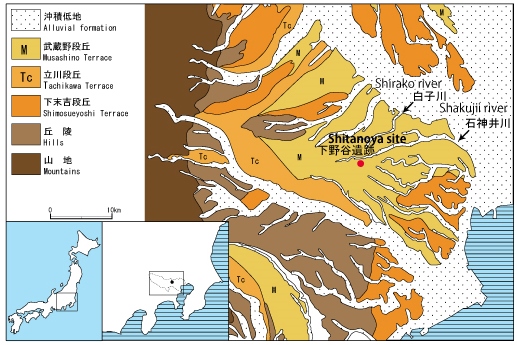
The Shitanoya site is on the plateau spreading south from the Shakujii-gawa River. This plateau is split into east and west by a shallow valley at a point in the path through Ome-Kaido from what is now Higashi-fushimi station. We now know that the east side and west side each had a settlement in the Middle Jomon period, 5,000 to 4,000 years ago.
The west settlement was roughly circular with a 150 m or so radius, while the east settlement was elliptical, spanning about 300 m east to west and 170 m north to south. Both were large, with the east settlement in particular being one of the largest in Japan.
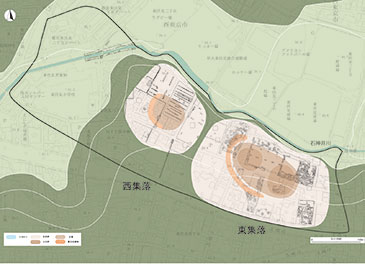
Shitanoya site map
![]() Download file. Opens new window. Expanded map of the Shitanoya site(PDF:1,216KB)
Download file. Opens new window. Expanded map of the Shitanoya site(PDF:1,216KB)
Village structure of the Shitanoya site
The Shitanoya site settlement was typically structured for Middle Jomon period settlement.
Excavation of the site showed that the remains of round houses called pit dwellings (a) made by digging out a floor were distributed in a ring. There were also remains of several rectangular buildings called pillar buildings (b) that were built of only pillars, without digging a floor. The ring where the buildings were distributed has many pits called earthen pits (c) that are thought to be a plaza with graves.
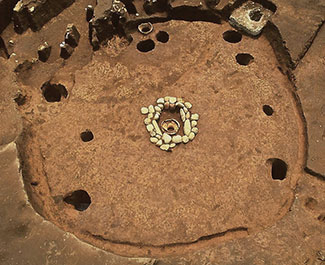
a. Pit dwelling
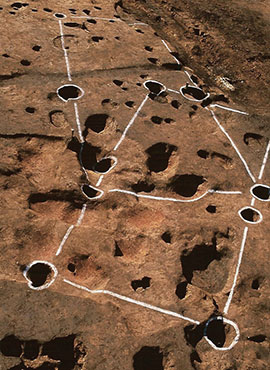
b. Pillar building
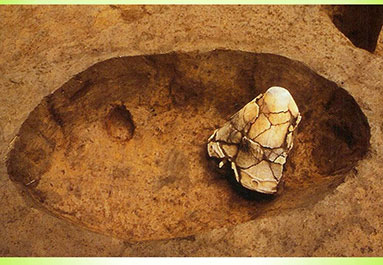
c. Earthen pit (pit burial)
This type of settlement is called a settlement with semi-circular for its donut-shaped distribution of buildings surrounding the plaza with graves.
In the Shitanoya site, two of these settlements with semi-circular were found next to one another, one to the east and one to the west, so this unique formation is called a multiple settlement with semi-circular. This formation of multiple neighboring large settlements is known to be the feature of settlement that was the hubs for the region.
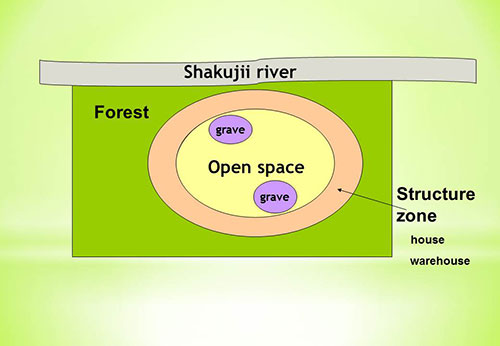
a. Typical village of the Jomon period, called a “settlement with semi-circular”
Regional base, home of the Jomon people
The number of sites increases exponentially from the Middle Jomon period, and archaeological sites are distributed in a continuous line along the river. Several large settlements like those of the Shitanoya site has been found, so it is thought to be the area’s hub.
Shitanoya Village was the center of the settlement along the Shakujii-gawa River, and Jomon people went in and out of the village as if it were their hometown.
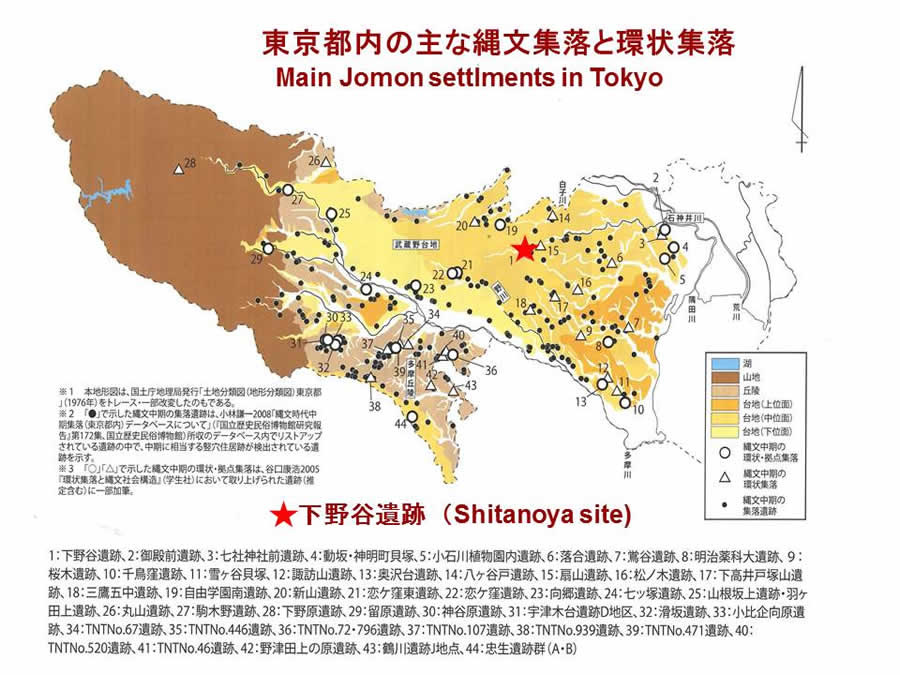
Archaeological remains discovered at the Shitanoya site
An enormous amount of pottery and stone tools has been discovered in the Shitanoya site. However, unfortunately, no human or animal bones, wood, or other organic material has been found as these do not preserve well in volcanic ash soil.
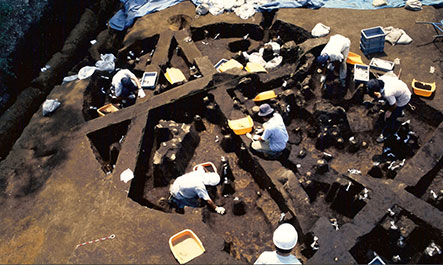
Pottery and stone tools discovered at the dwelling sites
The archaeological remains excavated from the Shitanoya site can be seen at the Nishitokyo Local Historical Museum.
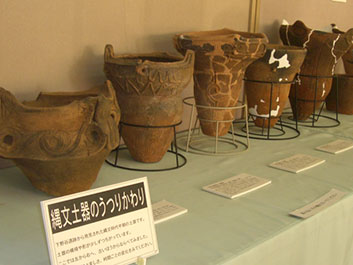
Nishitokyo Local Historical Museum
Pottery
Pottery discovered in the Shitanoya site was in the main style used in the middle to late part of the Middle Jomon period from 5,000 to 4,000 years ago in the southern Kanto region. They are called Katsusaka-type and Kasori E-type pottery.
In the middle of the Middle Jomon period from which Katsusaka-type pottery (a) was unearthed, the pottery was the most dynamically shaped and patterned of all Jomon styles. The late Taro Okamoto who was a leading painter in Japan became aware of the magnificence of primitive art after seeing this type of Jomon pottery.
Next, Kasori E-type pottery (b) features a beautifully curved, symmetrical shape with a slightly bulbous middle and swirling patterns on the rim of a pot.
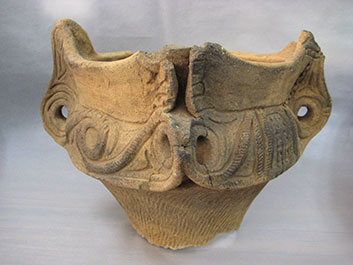
a. Katsusaka-type pottery
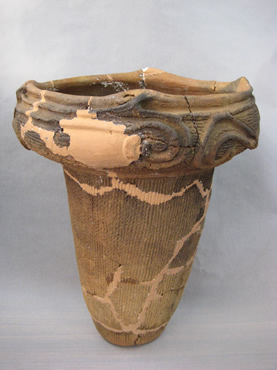
b. Kasori E-type pottery
Stone tools
Among stone tools, a particularly large number of chipped stone axes (a) have been unearthed that are thought to have been tools for digging the soil. Ground stone axe heads (a) used to cut down trees have also been excavated. Many grindstone and saddlequern (b) that are thought to have been tools for grinding nuts have also been found. There are also bows and arrows that were a major Jomon period invention, used to hunt deer, wild boar, and other small- and medium-sized animals, and many arrowheads (flint arrowheads) (c) have been unearthed.
This shows that most people cleverly used animal and plant resources from the forests surrounding the village.
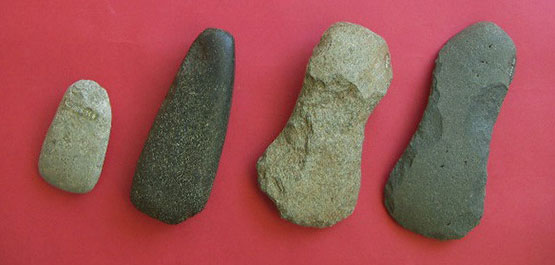
a. Ground stone axe head (Left 2) b. Chipped stone axe head (Right 2)
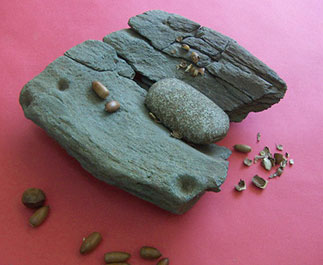
b. Grindstone (top), Saddle quern (bottom)

c. Flint arrowhead
Use of biomass
Careful observation of pottery chips excavated at the Shitanoya site shows strange pock marks on them. Analysis of molds made by injecting silicon into the marks discovered calybia nuts, wild soybeans, adzuki beans, cultivated plant egoma (a type of perilla), and other species. Further analysis of the size of the soybeans showed some the same size and some larger than the wild type, suggesting that there is a possibility that the people may have begun simple cultivation.
The area around the village was covered in broad-leaved trees, most of which were chestnut trees that were used as materials for homes and dugout canoes as well as for food. It is also apparent that the people were managing the forests, for example by thinning them to let in sunlight.
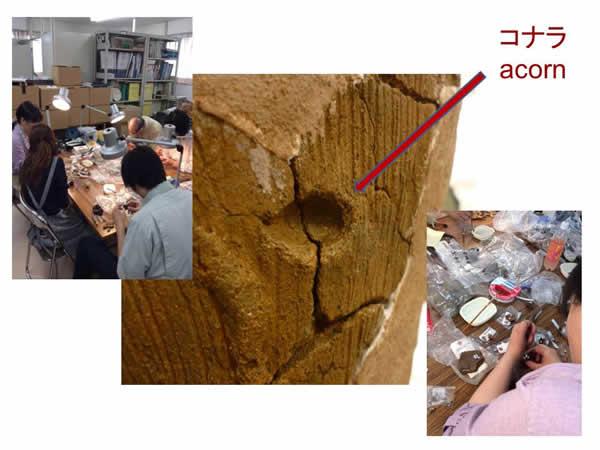
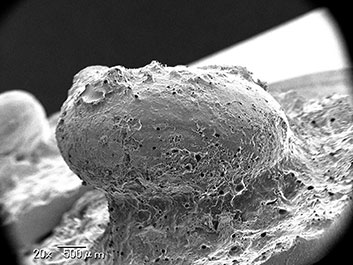
Replica microscopic photos of plant vestige on pottery a. Soybean
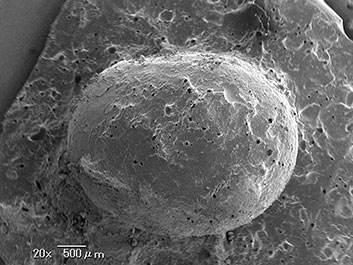
b. Soybean (Microscopic photo by: Hana Yamamoto)
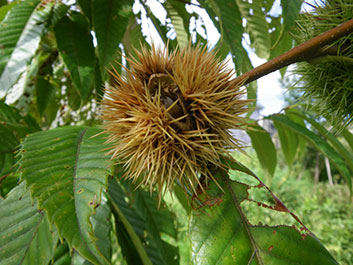
Chestnut (Living species: Shitanoya Archaeological Park)
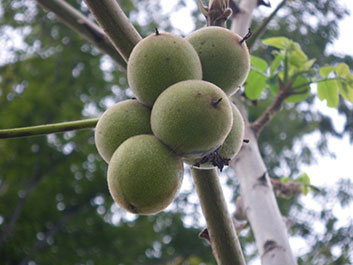
Walnut (Living species: Shitanoya Archaeological Park)
A vast network that the archeological remains teach us
In addition to southern Kanto pottery, the shapes and patterns of pottery from far away eastern Kanto and the Koshinetsu regions has also been discovered at the Shitanoya site, showing that information was moving around a large area and that people had networks.
These broad networks are also apparent from the production areas of raw materials used in stone tools, for example.
Scientific analysis of the obsidian that was often used to make arrowheads for the ends of arrows, one major Jomon invention, shows that it was brought in from various production places including Shinshu and Kouzushima Island, Izu.
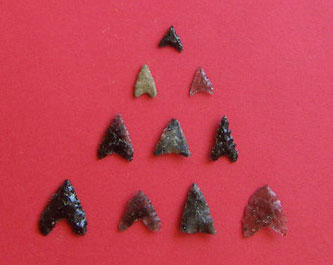
b. Flint arrowhead made from obsidian procured from far away
The accessories of the Jomon people
The people of Shitanoya Village had rich spirituality as can be seen from the highly artistic Jomon wares they made. Pierced earrings, pendants, and other accessories have also been found that are thought to have been used for not only style, but also as charms and to show one’s social status.
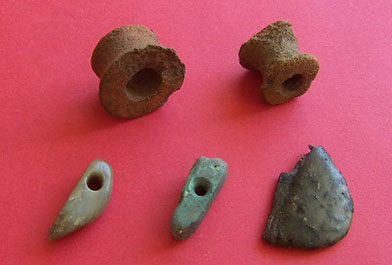
Upper: Baked clay pierced earrings Lower: Stone-made pendants
An autumn day in Shitanoya Village
Let us look at a day in autumn in Shitanoya Village 5,000 years ago.
It looks like people built a village on top of the well-sunlit plateau spreading to the north of Shakujii-gawa River. There are pit dwellings built in a ring in the village that was created by clearing a site in the broad-leaved tree forest with a plaza with graves of the village ancestors in the center field.
On this clear autumn day, the plaza is strewn with chestnuts gathered from the surrounding forest. The children are chasing wild boar piglets and you can hear their shouts as they play.
From the forest, men who have hunted down deer come back together with their hunting dogs. It looks like they have also brought the rabbits that fell into their pitfalls.
At the Shakujii-gawa River, people are busy fishing and soaking chestnuts in water. The river is an important route for transportation between the seaside village and faraway mountain villages.
They live a rich and peaceful life, with villages linked in a network, coexisting with nature.
About 5,000 to 4,000 years ago, which is when the large Shitanoya site settlement was formed, several civilizations were flourishing around the world, and the pyramids were being built in Egypt. During this same time, a rich culture that coexisted with nature and survived on hunting and gathering was thriving in the Japanese islands. The village is thought to have been free of war, as no protective devices like moats or fences nor any archaeological remains that could be considered as weapons were found. It is a great mystery as to why this distinctive culture flourished on the Japanese islands. Nevertheless, Jomon culture teaches many things to us living in modern times.
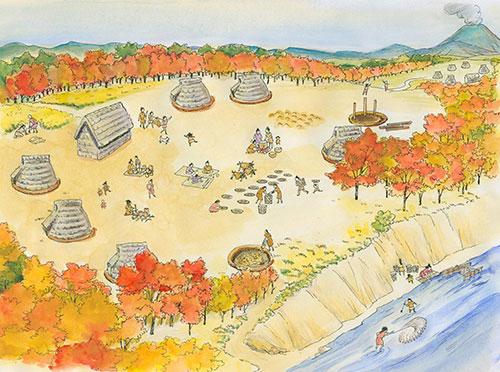
Shitanoya Village imagined (Drawn by: Ayano Morio)
Shiita and Noya: Now are you familiar with the Shitanoya site where we lived? Look! There is a festival over there. We also had festivals in our times, but this looks like fun too!
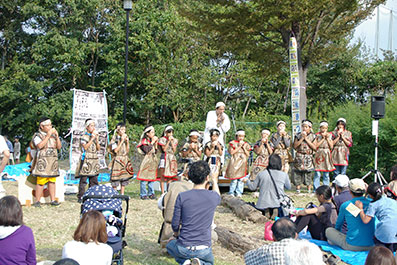
Jomon Forest Autumn Festival 1
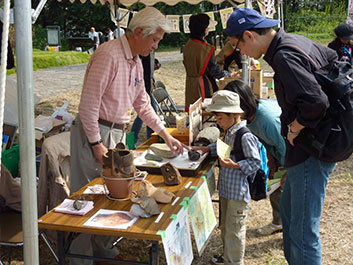
Jomon Forest Autumn Festival 2
In 2007, the Shitanoya Archaeological Park was built on part of the site to preserve the ground below, with the aim of protecting the site. It is a peaceful park with replicas of the frames of houses restored to two-thirds size from dwellings discovered, a strata panel, and chestnut and walnut trees that were favored by the Jomon people. You can get a sense of the location and scenery the Jomon people chose for their village.
The park is also a place for visitors to learn about the Jomon period and the importance of the site, for example through the Jomon Forest Autumn Festival.
Please visit us while learning about the wonders of Jomon culture.
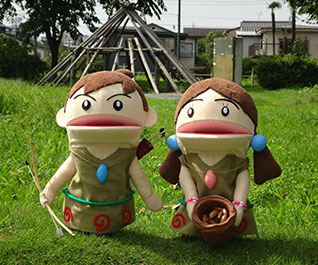
Shitanoya Archaeological Park and Shiita and Noya of Shitanoya Village
About a 25-minute ride from Shinjuku to Higashi-fushimi station on the Seibu-shinjuku line and then a 10-minute walk. The Shitanoya site, a miracle Jomon period world awaits you.
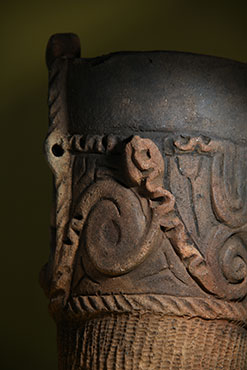
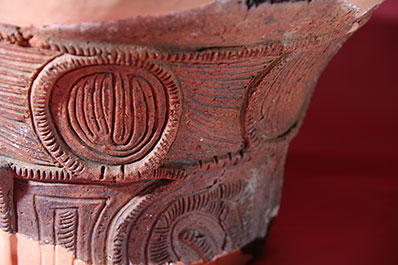
The Shitanoya site has been designated as a national historic site, a nation’s treasure to be preserved for the future.
Let’s all protect it together!
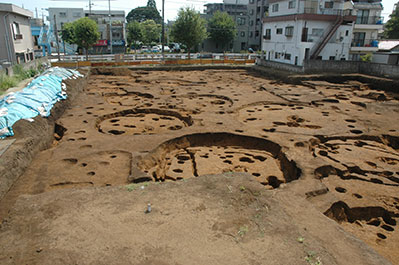
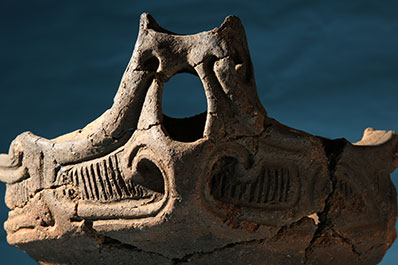
Nishitokyo City GUIDE
![]() Download file. Opens new window. Nishitokyo City GUIDE(PDF:3,614KB)
Download file. Opens new window. Nishitokyo City GUIDE(PDF:3,614KB)
